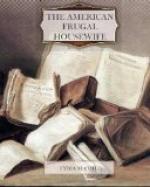ESCALOPED OYSTERS.—Put crumbled bread around the sides and bottom of a buttered dish. Put oysters in a skillet, and let the heat just strike them through; then take them out of the shells, and rinse them thoroughly in the water they have stewed in. Put half of them on the layer of crumbled bread, and season with mace and pepper; cover them with crumbs of bread and bits of butter; put in the rest of the oysters, season and cover them in the same way. Strain their liquor, and pour over. If you fear they will be too salt, put fresh water instead. Bake fifteen or twenty minutes.
FRIED OYSTERS.—After they are prepared from the shell, they are dipped in batter, made of eggs and crumbs, seasoned with nutmeg, mace and salt, stirred up well. Fried in lard till brown.
VEGETABLE OYSTER.—This vegetable is something like a parsnip; is planted about the same time, ripens about the same time, and requires about the same cooking. It is said to taste very much like real oysters. It is cut in pieces, after being boiled, dipped in batter, and fried in the same way. It is excellent mixed with minced salt fish.
PARTRIDGES should be roasted ten or fifteen minutes longer than chickens, that is, provided they are thick-breasted and plump. Being naturally dry, they should be plentifully basted with butter.
* * * * *
EXTRACTS FROM THE ENGLISH FRUGAL HOUSEWIFE.
[It was the intention of the author of the American Frugal Housewife, to have given an Appendix from the English Frugal Housewife; but upon examination, she found the book so little fitted to the wants of this country, that she has been able to extract but little.]
CHEESE is to be chosen by its moist, smooth coat; if old cheese be rough-coated, ragged, or dry at top, beware of worms. If it be over-full of holes, moist and spongy, it is subject to maggots. If soft or perished places appear, try how deep they go, for the worst part may be hidden.
EGGS.—To prove whether they are good or bad, hold the large end of the egg to your tongue; if it feels warm, it is new; but if cold, it is bad. In proportion to the heat or cold, is the goodness of the egg. Another way to know is to put the egg in a pan of cold water; the fresher the egg, the sooner it will fall to the bottom; if rotten, it will swim. If you keep your eggs in ashes, salt or bran, put the small end downwards; if you turn them endways once a week, they will keep some months.
VEAL.—If the vein in the shoulder look blue or bright red, it is newly killed; but if black, green, or yellow, it is stale. The leg is known to be new by the stiffness of the joint. The head of a calf or a lamb is known by the eyes; if sunk or wrinkled, it is stale; if plump and lively, it is fresh.
MUTTON.—If it be young, the flesh will pinch tender; if old, it will wrinkle and remain so. If young, the fat will easily part from the lean; if old, it will stick by strings and skins. Strong, rancid mutton feels spongy, and does not rise again easily, when dented. The flesh of ewe mutton is paler, of a closer grain, and parts more easily.




